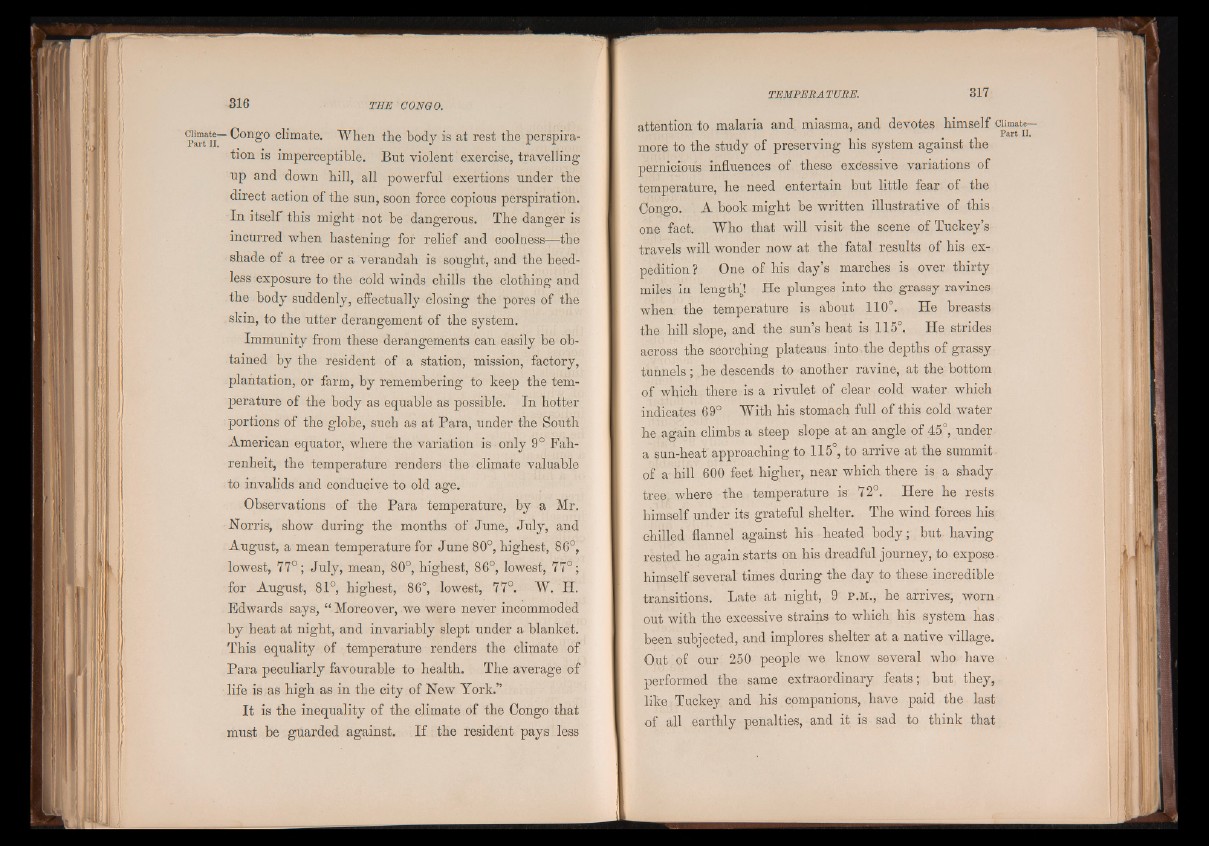
- Congo climate. When the body is at rest the perspiration
is imperceptible. But violent exercise, travelling
up and down hill, all powerful exertions under the
direct action of the sun, soon force copious perspiration.
In itself this might not he dangerous. The danger is
incurred when hastening for relief and coolness—the
shade of a tree or a verandah is sought, and the heedless
exposure to the cold winds chills the clothing and
the body suddenly, effectually closing the pores of the
sldn, to the utter derangement of the system.
Immunity from these derangements can easily he obtained
by the resident of a station, mission, factory,
plantation, or farm, by remembering to keep the temperature
of the body as equable as possible. In hotter
portions of the globe, such as at Para, under the South
American equator, where the variation is only 9° Fahrenheit,
the temperature renders the climate valuable
to invalids and conducive to old age.
Observations of the Para temperature, by a Mr.
Morris, show during the months of June, July, and
August, a mean temperature for June 80°, highest, 86°,
lowest, 77°; July, mean, 80°, highest, 86°, lowest, 77°;
for August, 81°, highest, 86°, lowest, 77°. W. H.
Edwards says, “ Moreover, we were never incommoded
by heat at night, and invariably slept under a blanket.
This equality of temperature renders the climate of
Para peculiarly favourable to health. The average of
life is as high as in the city of New York.”
I t is the inequality of the climate of the Congo that
must be guarded against. If the resident pays less
attention to malaria and miasma, and devotes himself climate—
P a rt II.
more to the study of preserving his system against the
pernicious influences of these excessive variations of
temperature, he need entertain but little fear of the
Congo. A book might be written illustrative of this
one fact. Who that will visit the scene of Tuckey’s
travels will wonder now at the fatal results of his expedition?
One of his day’s marches is over thirty
miles in length! He plunges into the grassy ravines
when the temperature is about 110°. He breasts
the hill slope, and the sun’s heat is 115°. He strides
across the scorching plateaus into the depths of grassy
tunnels; he descends to another ravine, at the bottom
of which there is a rivulet of clear cold water which
indicates 69° With his stomach full of this cold water
he again climbs a steep slope at an angle of 45°, under,
a sun-heat approaching to 115°, to arrive at the summit
of a-hill 600 feet higher, near which there is a shady
tree, where the temperature is 72°. Here he rests
himself under its grateful shelter. The wind forces his
chilled flannel against his heated body; but having
rested he again starts on his dreadful journey, to expose
himself several times during the day to these incredible
transitions. Late at night, 9 p .m . , he arrives, worn-
out with the excessive strains to which his system has
been subjected, and implores shelter at a native village.
Out of our 250 people we know several who have
performed the same extraordinary feats; but they,
like Tuckey and his companions, have paid the last
of all earthly penalties, and it is sad to think that